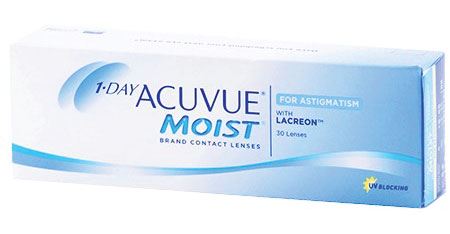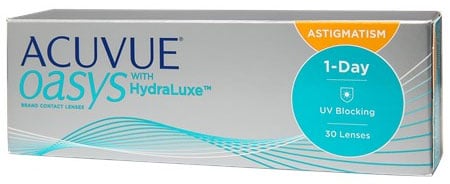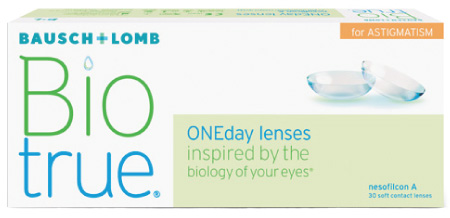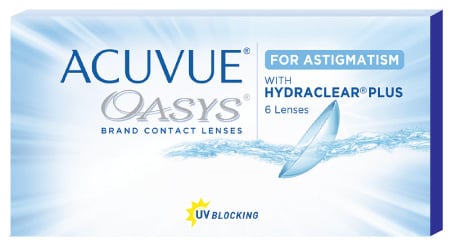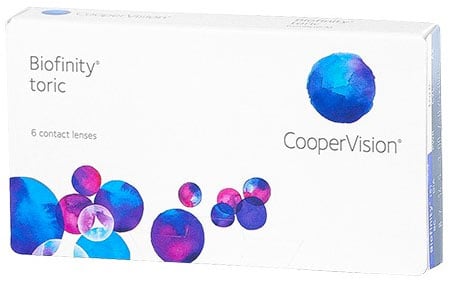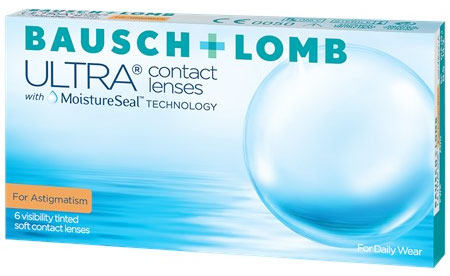An astigmatism is a type of refractive error that causes blurry vision. It is caused when the cornea (the clear front part of the eye) or the lens (a clear structure inside of the eye that allows for focusing) is irregularly shaped. Astigmatism can be corrected with toric contact lenses.
- Refractive error is a word used by vision specialists to describe the way the eye “refracts” (or bends) light. This is the basis for a glasses prescription.
- Other examples of refractive error are nearsightedness and farsightedness. These can, and commonly do, occur with astigmatism.
The cornea is crucial because it refracts light that enters the eye to a single point inside of the eye to allow for clear vision. In astigmatism, because of the irregular cornea or lens shape, light does not focus to a single point. As a result, this causes the vision to be blurry for people with astigmatism.
- The lens is a clear structure on the inside of the eye that allows the eye to focus up close. Sometimes, irregularities in this shape can also cause astigmatism.
Some rarer causes of astigmatism include eye injuries, surgeries, or disease.

What are the Symptoms of Astigmatism?
The most common symptom is blurry vision up close and far away. People with astigmatism also may notice halos around lights and difficulty driving at night. This is because the pupil gets big at night (pupil dilation), allowing for more light to enter the eye and more blur. Other symptoms include eyestrain, headaches, and squinting.
- Blurred vision
- Halos around lights
- Eyestrain
- Headaches
- Squinting
- Dry eyes
How Common is Astigmatism?
Astigmatism is very prevalent, and studies show that up to 40% of American adults have astigmatism. The rate for children ages 5-17 is lower at roughly 28%. Thankfully, astigmatism is not a scary disease, just a refractive error.
People who are nearsighted or farsighted can also have astigmatism, and it can range from being very mild to very severe.
How is Astigmatism Diagnosed?
Your optometrist or ophthalmologist can easily diagnose astigmatism with a comprehensive eye exam. They can either use special instruments called a keratometer (this measures the curvature of the cornea) or simply use your refraction to diagnose astigmatism. Your refraction is simply the process of determining what eye prescription you need to achieve crisp near and far vision. Sometimes, your optometrist can even use the extent of your vision without glasses as an estimate for the amount of your astigmatism.
How is Astigmatism Treated?
Like hyperopia, astigmatism is commonly treated with prescription glasses or toric contact lenses. Instead of having one power throughout the entire pair of glasses or contacts, there are different powers in different parts of the lens.
This characteristic is why sometimes it can be hard to choose a good contact lens when you have astigmatism because if the lenses move, the powers will move too, causing further blurred vision.
Contact lenses that correct astigmatism are often called toric contact lenses.
Finally, surgical methods like LASIK can correct for astigmatism as well. LASIK is a procedure that uses a laser to change the shape of the cornea to change refractive error. It can help reduce mild to moderate amounts of astigmatism.
Non-surgical methods, such as Ortho-K, can also reduce astigmatism. Ortho-K involves wearing a hard contact lens overnight to reshape the front of the eye, allowing for clear vision all day without glasses.
Can You Drive with Astigmatism?
Driving without your glasses or contacts is never going to give you the best vision to ensure your safety (or the safety of your passengers and other drivers on the road). Some patients with mild amounts of astigmatism may find that they still can see without their glasses, but to be as safe as possible, you should always wear your glasses or contact lenses while driving.
Because of the changes in pupil size that occur at night, many people with astigmatism have difficulty with night driving. Issues can include glare, blur, and halos around lights. Each state has specific guidelines for driving, speak to your optometrist or ophthalmologist to determine if your uncorrected vision meets those guidelines.
What are Some Contact Lens Options for Astigmatism?
Now more than ever, patients with astigmatism have more options for the treatment of astigmatism. These lenses have special mechanisms to make sure that they don’t rotate, so they tend to be more expensive than non-astigmatism contacts.
Some of these mechanisms include thin-thick zones and heavier parts of the contact so that they sit in a specific orientation.
Daily Lenses Include:
1 Day Acuvue Moist for Astigmatism 30 Pack
- Also available in a 90 Pack
Acuvue Oasys 1 Day For Astigmatism 30 Pack
- Also available in a 90 Pack
Dailies Aquacomfort Plus Toric 30 Pack
- Also available in a 90 Pack
Soflens Daily Disposable Toric for Astigmatism
Biotrue Oneday Astigmatism 30 Pack
- Also available in a 90 Pack
Precision 1 Daily for Astigmatism 90 Pack
- Also available in a 30 Pack
Two-Week Lenses Include:
Acuvue Oasys for Astigmatism
- Read our full Acuvue Oasys for Astigmatism Review
Avaira Vitality Toric
Biomedics Toric
Monthly Lenses Include:
Air Optix for Astigmatism
Air Optix Plus HydraGlyde for Astigmatism
Biofinity Toric
Acuvue Vita for Astigmatism
Bausch + Lomb Ultra for Astigmatism
There are also specialty hard contact lenses for patients with large amounts of astigmatism or keratoconus. Your eye doctor will help you decide which lens is best for your eye and your visual needs.

Dr. Morgan Jones is a Doctor of Optometry (O.D.) completing a residency in ocular disease. She has experience in diabetic research, along with several years of clinical research. Along with being a community outreach leader and an avid mentor and tutor, she enjoys educating outside of clinic. Dr. Jones has a B.A. in Biology from Texas A&M University.

